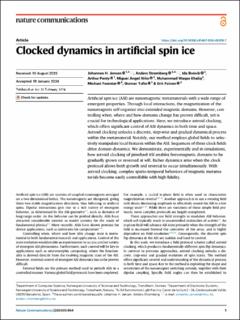| dc.contributor.author | Jensen, Johannes Høydahl | |
| dc.contributor.author | Strømberg, Anders | |
| dc.contributor.author | Breivik, Ida | |
| dc.contributor.author | Penty, Arthur George | |
| dc.contributor.author | Nino, Miguel Angel | |
| dc.contributor.author | Khaliq, Muhammad Waqas | |
| dc.contributor.author | Foerster, Michael | |
| dc.contributor.author | Tufte, Gunnar | |
| dc.contributor.author | Folven, Erik | |
| dc.date.accessioned | 2024-02-05T10:17:15Z | |
| dc.date.available | 2024-02-05T10:17:15Z | |
| dc.date.created | 2024-02-01T14:28:29Z | |
| dc.date.issued | 2024 | |
| dc.identifier.issn | 2041-1723 | |
| dc.identifier.uri | https://hdl.handle.net/11250/3115536 | |
| dc.description.abstract | Artificial spin ice (ASI) are nanomagnetic metamaterials with a wide range of emergent properties. Through local interactions, the magnetization of the nanomagnets self-organize into extended magnetic domains. However, controlling when, where and how domains change has proven difficult, yet is crucial for technological applications. Here, we introduce astroid clocking, which offers significant control of ASI dynamics in both time and space. Astroid clocking unlocks a discrete, step-wise and gradual dynamical process within the metamaterial. Notably, our method employs global fields to selectively manipulate local features within the ASI. Sequences of these clock fields drive domain dynamics. We demonstrate, experimentally and in simulations, how astroid clocking of pinwheel ASI enables ferromagnetic domains to be gradually grown or reversed at will. Richer dynamics arise when the clock protocol allows both growth and reversal to occur simultaneously. With astroid clocking, complex spatio-temporal behaviors of magnetic metamaterials become easily controllable with high fidelity. | |
| dc.language.iso | eng | en_US |
| dc.publisher | Nature | en_US |
| dc.relation.uri | https://www.nature.com/articles/s41467-024-45319-7 | |
| dc.rights | Navngivelse 4.0 Internasjonal | * |
| dc.rights.uri | http://creativecommons.org/licenses/by/4.0/deed.no | * |
| dc.title | Clocked dynamics in artificial spin ice | en_US |
| dc.title.alternative | Clocked dynamics in artificial spin ice | en_US |
| dc.type | Peer reviewed | en_US |
| dc.type | Journal article | en_US |
| dc.description.version | publishedVersion | |
| dc.subject.nsi | VDP::Kondenserte fasers fysikk: 436 | |
| dc.subject.nsi | VDP::Condensed matter physics: 436 | |
| dc.subject.nsi | VDP::Kondenserte fasers fysikk: 436 | |
| dc.subject.nsi | VDP::Condensed matter physics: 436 | |
| dc.subject.nsi | VDP::Kondenserte fasers fysikk: 436 | |
| dc.subject.nsi | VDP::Condensed matter physics: 436 | |
| dc.subject.nsi | VDP::Kondenserte fasers fysikk: 436 | |
| dc.subject.nsi | VDP::Condensed matter physics: 436 | |
| dc.source.volume | 15 | en_US |
| dc.source.journal | Nature Communications | en_US |
| dc.source.issue | 1 | en_US |
| dc.identifier.doi | 10.1038/s41467-024-45319-7 | |
| dc.identifier.cristin | 2242039 | |
| dc.relation.project | Norges forskningsråd: 270961 | |
| dc.relation.project | Norges forskningsråd: 331821 | |
| dc.relation.project | EC/H2020/861618 | |
| cristin.ispublished | true | |
| cristin.fulltext | original | |
| cristin.qualitycode | 2 | |

